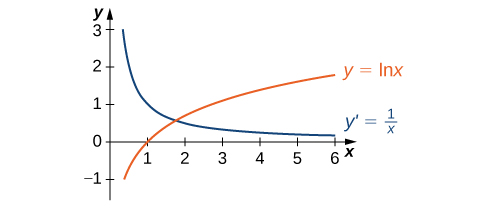Learning Outcomes
- Find the derivative of logarithmic functions
Now that we have the derivative of the natural exponential function, we can use implicit differentiation to find the derivative of its inverse, the natural logarithmic function.
The Derivative of the Natural Logarithmic Function
If [latex]x>0[/latex] and [latex]y=\ln x[/latex], then
More generally, let [latex]g(x)[/latex] be a differentiable function. For all values of [latex]x[/latex] for which [latex]g^{\prime}(x)>0[/latex], the derivative of [latex]h(x)=\ln(g(x))[/latex] is given by
Proof
If [latex]x>0[/latex] and [latex]y=\ln x[/latex], then [latex]e^y=x[/latex]. Differentiating both sides of this equation results in the equation
Solving for [latex]\frac{dy}{dx}[/latex] yields
Finally, we substitute [latex]x=e^y[/latex] to obtain
We may also derive this result by applying the inverse function theorem, as follows. Since [latex]y=g(x)=\ln x[/latex] is the inverse of [latex]f(x)=e^x[/latex], by applying the inverse function theorem we have
Using this result and applying the chain rule to [latex]h(x)=\ln(g(x))[/latex] yields
[latex]_\blacksquare[/latex]
The graph of [latex]y=\ln x[/latex] and its derivative [latex]\frac{dy}{dx}=\frac{1}{x}[/latex] are shown in Figure 3.

Figure 3. The function [latex]y=\ln x[/latex] is increasing on [latex](0,+\infty)[/latex]. Its derivative [latex]y^{\prime} =\frac{1}{x}[/latex] is greater than zero on [latex](0,+\infty)[/latex].
Example: Taking a Derivative of a Natural Logarithm
Find the derivative of [latex]f(x)=\ln(x^3+3x-4)[/latex]
Example: Using Properties of Logarithms in a Derivative
Find the derivative of [latex]f(x)=\ln\left(\dfrac{x^2 \sin x}{2x+1}\right)[/latex]
Try It
Differentiate: [latex]f(x)=\ln (3x+2)^5[/latex].
Watch the following video to see the worked solution to the above Try It.
Now that we can differentiate the natural logarithmic function, we can use this result to find the derivatives of [latex]y=\log_b x[/latex] and [latex]y=b^x[/latex] for [latex]b>0, \, b\ne 1[/latex].
Derivatives of General Exponential and Logarithmic Functions
Let [latex]b>0, \, b\ne 1[/latex], and let [latex]g(x)[/latex] be a differentiable function.
- If [latex]y=\log_b x[/latex], then
[latex]\frac{dy}{dx}=\dfrac{1}{x \ln b}[/latex]
More generally, if [latex]h(x)=\log_b (g(x))[/latex], then for all values of [latex]x[/latex] for which [latex]g(x)>0[/latex],
[latex]h^{\prime}(x)=\dfrac{g^{\prime}(x)}{g(x) \ln b}[/latex]
- If [latex]y=b^x[/latex], then
[latex]\frac{dy}{dx}=b^x \ln b[/latex]
More generally, if [latex]h(x)=b^{g(x)}[/latex], then
[latex]h^{\prime}(x)=b^{g(x)} g^{\prime}(x) \ln b[/latex]
Proof
If [latex]y=\log_b x[/latex], then [latex]b^y=x[/latex]. It follows that [latex]\ln(b^y)=\ln x[/latex]. Thus [latex]y \ln b = \ln x[/latex]. Solving for [latex]y[/latex], we have [latex]y=\frac{\ln x}{\ln b}[/latex]. Differentiating and keeping in mind that [latex]\ln b[/latex] is a constant, we see that
The derivative from above now follows from the chain rule.
If [latex]y=b^x[/latex], then [latex]\ln y=x \ln b[/latex]. Using implicit differentiation, again keeping in mind that [latex]\ln b[/latex] is constant, it follows that [latex]\frac{1}{y}\frac{dy}{dx}=\text{ln}b.[/latex] Solving for [latex]\frac{dy}{dx}[/latex] and substituting [latex]y=b^x[/latex], we see that
The more general derivative follows from the chain rule.
[latex]_\blacksquare[/latex]
Example: Applying Derivative Formulas
Find the derivative of [latex]h(x)= \dfrac{3^x}{3^x+2}[/latex]
Example: Finding the Slope of a Tangent Line
Find the slope of the line tangent to the graph of [latex]y=\log_2 (3x+1)[/latex] at [latex]x=1[/latex].
Try It
Find the slope for the line tangent to [latex]y=3^x[/latex] at [latex]x=2[/latex].
Watch the following video to see the worked solution to the above Try It.
Try It
Candela Citations
- 3.9 Derivatives of Exponential and Logarithmic Functions. Authored by: Ryan Melton. License: CC BY: Attribution
- Calculus Volume 1. Authored by: Gilbert Strang, Edwin (Jed) Herman. Provided by: OpenStax. Located at: https://openstax.org/details/books/calculus-volume-1. License: CC BY-NC-SA: Attribution-NonCommercial-ShareAlike. License Terms: Access for free at https://openstax.org/books/calculus-volume-1/pages/1-introduction
